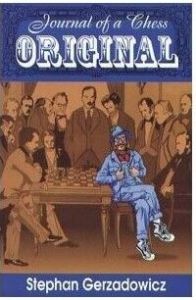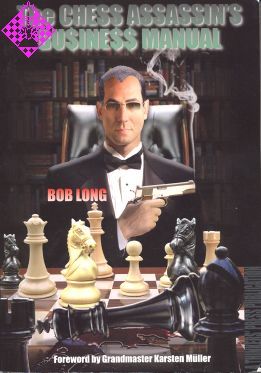Artikelnummer
LXLONTCABM
Autor
The Chess Assassin's Business Manual
Stories and Methods
295 Seiten, kartoniert, Thinkers' Press, 1. Auflage 2008
Final vergriffen
FOREWORD
"What is the connection between chess, an assassin, and business, and how can that connection help you to improve your chess?" I can hear you asking.Let me start with the first two parts of the title: playagainst great attacking geniuses like Tal or Nezhmetdinov ''automatically feels like you were in his rifle's crosshairs," Long shows impressive examples of this phenomenon and beautiful games. But how do you develop the killer instinct of a chess assassin? Here comes the business part of the title into play. Long uses his long experience as a business man not only to shed light into the world of the chess business, but also to explain the parallels to chess and to draw conclusions like the following:
A) Easy does not do it
This is applicable in the chess and business world: "Too many of us are in a hurry for the secret, the alchemy that will make us rich, brainier or, offer an easier life. We know that's a waste of time but, I've done it too. If we just ask someone who already knows we can save time." Instead "good chess is mostly HARD WORK. Studying haphazwill not work. Settle onto something and stick with it even when you lose." This leads to
B) How to get better?
Hard work is the order of the day: "Do you remember the amount of work So and So has put in? Have you done that? Followed a system? Worked it? Dilettantism (extraorsuperficial) is only good IF you are extremely tallike Gottfried Leibniz vs. Isaac Newton."
C) How to study tactics?
Learning and repeating motifs is very important at the beginning as the full complexity of chess is othertoo difficult to grasp: "There seem to be two types of 'tactics' books or software out there:
1) One topic per chapter, say 15-16 chapters, full of exto give you a feel for patterns and examples; and
2) The mixed bag approach, everything in the pot, as that is the way the "real" world is. The first is necessary to show us "patterns" ...If we don't know the patterns, the 'brute force' method can take a long time to master, if indeed it can be mastered. And without the first, it is a huge time-waster."
D) When is enough enough?
The typical business approach well explained by Long is illustrated with an example: "Would you like a piece of our great pumpkin pie now?" My waitress politely asked. "No thanks," was my answer, "but if you ask my budseveral more times he will cave in and say yes." It's called "upselling" and it is everywhere. Smart business people have always done this and so have smart waiters and waitresses. But now it is ubiquitous and everyone is trying to get into your wallet." It is nowadays also common in the chess world: "There are many grandmasters these days who trot out opening schemes with the idea of using them ONCE and once only." Following a path that a strong grandmaster has played only once may be a dangerous business.
E) Don't let success go to your head. By the same reasoning, don't let failure make you feel like givup.
Long gives insights into his own approach to navithis problem: "I already know I am good at a lot of things, but that doesn't make me think I am better than someone else is, yet... this is what others keep trying to prove, and it seems to bug them that I don't care in a perway."
Furthermore he underlines the value of pattern recand puts it into perspective, gives many useful guidelines, and shows ways to improve your strength. But the many included games ensure that you will imwhile having fun, so lean back, read, and enjoy!
GM Dr. Karsten Müller
Germany
| EAN | 9781888710175 |
|---|---|
| Gewicht | 600 g |
| Hersteller | Thinkers' Press |
| Breite | 17,8 cm |
| Höhe | 25,5 cm |
| Medium | Buch |
| Erscheinungsjahr | 2008 |
| Autor | Bob Long |
| Sprache | Englisch |
| Auflage | 1 |
| ISBN-10 | 1888710179 |
| ISBN-13 | 9781888710175 |
| Seiten | 295 |
| Einband | kartoniert |
| Name | Thinkers' Press |
|---|
005 Foreword
007 Preface
Section One: Business
012 Two Companies
023 Enough
031 Easy Does Not Do It
033 Bad Customers
039 Side Effects
057 Buying
063 Niche City
Section Two: Business and Chess
072 Believability
075 Advertising
081 Reviews
085 Events
091 Perception
105 Software
107 Pet Theories
113 Things of All Kinds
121 Character
Section Three: Chess
136 Misplaced Pride
143 A Kramnik Tip
151 Memory
157 Rx for Danger
161 Opening Scrutiny
165 Emotions
169 Yin and Yang
185 Weirdness
189 Spirit and TIPS
195 New Stuff?
203 French Insanity
213 Tactics
221 Combinations
Section Four: Bonus Round
228 Stories
285 Business
295 Colophon
007 Preface
Section One: Business
012 Two Companies
023 Enough
031 Easy Does Not Do It
033 Bad Customers
039 Side Effects
057 Buying
063 Niche City
Section Two: Business and Chess
072 Believability
075 Advertising
081 Reviews
085 Events
091 Perception
105 Software
107 Pet Theories
113 Things of All Kinds
121 Character
Section Three: Chess
136 Misplaced Pride
143 A Kramnik Tip
151 Memory
157 Rx for Danger
161 Opening Scrutiny
165 Emotions
169 Yin and Yang
185 Weirdness
189 Spirit and TIPS
195 New Stuff?
203 French Insanity
213 Tactics
221 Combinations
Section Four: Bonus Round
228 Stories
285 Business
295 Colophon
Was verbirgt sich hinter dem martiaTitel "Des Schach-Meuchelörders Geschäfts-Handbuch"? Wo noch dazu auf dem Titelbild ein smarter Killer mit schwarzem AnFliege und getönter Brille mit einem rauchenden Revolver in der Hand vor einem Schachbrett mit ei„umgelegten" und blutenden schwarzen König posiert?
Nun, die erste Antwort könnte lauDie Amerikaner lieben äußere Effekte. Die zweite Antwort ist: Der Autor Robert (Bob) Long als Grünund Chef des Verlages Thinkers Press Inc. will mit seinem autobiographie-ähnlichen Werk Einblicke in seine gesammelten Erfahrungen als Geschäftsmann und Schachspieler geben und erzählt daher eine Menge Geschichten aus seinem bewegten Leben. Long hat 35 Jahre lang einen Handel für Schachbedarf (Chessco) betrieben, 1973 seinen Verlag geündet und firmierte eine Zeitlang als Herausgeber einer Schachzeials Mathematik-Dozent und Schach-DVD-Produzent, neben anTätigkeiten.
Das Buch enthält folgende Kapitel:
1) Geschäft (S. 11-70): Hier berichLong über seine Projekte Chessund Thinkers Press, über notwenAnstrengungen im Job, über wahre Freunde, über schlechte Geäftspartner und schwierige Käusowie über (positive und negatiGeschäftspraktiken.
2) Geschäft und Schach (S. 71-134): Es geht um Glaubwürdigkeit, um Annoncen, um Buchbesprechungen (aha!?), um die Organisation von Schachfestivals (auch das hat sich Long angetan!), um Ausreden und Rechfertigungen der Verlierer, um das elektronische Zeitalter, sowie um Aberglauben, schlechtes Benehund den Charakter der Schach
3) Schach (S. 135-226): Beobachund Tipps hält der Verfasser in diesem Abschnitt bereit, etwa „Hochmut kommt vor dem Fall", schachliche Muster und Gedächtniskapazität, Forschergeist, Emotion und Objektivität, Verschrobenheiten, Überlegungen zur Französischen Verteidigung, Kombinationen (mit 17 Beispielen).
4) Bonus-Runde (S. 227-299): Der Autor erzählt in bunt gemischter Folge von der Schach-Leidenschaft, vom Reisen, vom Bücher-Verlegen, vom Schach-Humor, vom Verbesseauf verschiedenen Gevom Brainstorming, von Fehlern, von der Schach-Vermark(kann man mit Schach überGeld machen?), von Süchtivon Sammlern, von Filmen, ErComputer-Blogs u.a.m. Angereichert wird das Ganze von vieFotos, vornehmlich der Long' schen Familie, mit insgesamt 20 Parund 35 Partiefragmenten, sowie mit einem Vorwort des Hamburger GM Dr. Karsten Müller (S. 5 f). Wer sich dafür interessiert, was ein schachbegeisterter amerikanischer Geschäftsmann alles leisten kann, und gleichzeitig die englische (ameSprache beherrscht, für den dürfte das „Meuchelmörder"-Buch die richtige Wahl darstellen...
P.S. Der Autor hat einen Fortsetangekündigt unter dem Titel „The Experimenter" (S. 293).
Mit freundlicher Genehmigung
Dr. W. Schweizer, Rochade Europa 3/2009
Nun, die erste Antwort könnte lauDie Amerikaner lieben äußere Effekte. Die zweite Antwort ist: Der Autor Robert (Bob) Long als Grünund Chef des Verlages Thinkers Press Inc. will mit seinem autobiographie-ähnlichen Werk Einblicke in seine gesammelten Erfahrungen als Geschäftsmann und Schachspieler geben und erzählt daher eine Menge Geschichten aus seinem bewegten Leben. Long hat 35 Jahre lang einen Handel für Schachbedarf (Chessco) betrieben, 1973 seinen Verlag geündet und firmierte eine Zeitlang als Herausgeber einer Schachzeials Mathematik-Dozent und Schach-DVD-Produzent, neben anTätigkeiten.
Das Buch enthält folgende Kapitel:
1) Geschäft (S. 11-70): Hier berichLong über seine Projekte Chessund Thinkers Press, über notwenAnstrengungen im Job, über wahre Freunde, über schlechte Geäftspartner und schwierige Käusowie über (positive und negatiGeschäftspraktiken.
2) Geschäft und Schach (S. 71-134): Es geht um Glaubwürdigkeit, um Annoncen, um Buchbesprechungen (aha!?), um die Organisation von Schachfestivals (auch das hat sich Long angetan!), um Ausreden und Rechfertigungen der Verlierer, um das elektronische Zeitalter, sowie um Aberglauben, schlechtes Benehund den Charakter der Schach
3) Schach (S. 135-226): Beobachund Tipps hält der Verfasser in diesem Abschnitt bereit, etwa „Hochmut kommt vor dem Fall", schachliche Muster und Gedächtniskapazität, Forschergeist, Emotion und Objektivität, Verschrobenheiten, Überlegungen zur Französischen Verteidigung, Kombinationen (mit 17 Beispielen).
4) Bonus-Runde (S. 227-299): Der Autor erzählt in bunt gemischter Folge von der Schach-Leidenschaft, vom Reisen, vom Bücher-Verlegen, vom Schach-Humor, vom Verbesseauf verschiedenen Gevom Brainstorming, von Fehlern, von der Schach-Vermark(kann man mit Schach überGeld machen?), von Süchtivon Sammlern, von Filmen, ErComputer-Blogs u.a.m. Angereichert wird das Ganze von vieFotos, vornehmlich der Long' schen Familie, mit insgesamt 20 Parund 35 Partiefragmenten, sowie mit einem Vorwort des Hamburger GM Dr. Karsten Müller (S. 5 f). Wer sich dafür interessiert, was ein schachbegeisterter amerikanischer Geschäftsmann alles leisten kann, und gleichzeitig die englische (ameSprache beherrscht, für den dürfte das „Meuchelmörder"-Buch die richtige Wahl darstellen...
P.S. Der Autor hat einen Fortsetangekündigt unter dem Titel „The Experimenter" (S. 293).
Mit freundlicher Genehmigung
Dr. W. Schweizer, Rochade Europa 3/2009
Mehr von Thinkers' Press
-
 Journal of a Chess Original15,00 €
Journal of a Chess Original15,00 €

